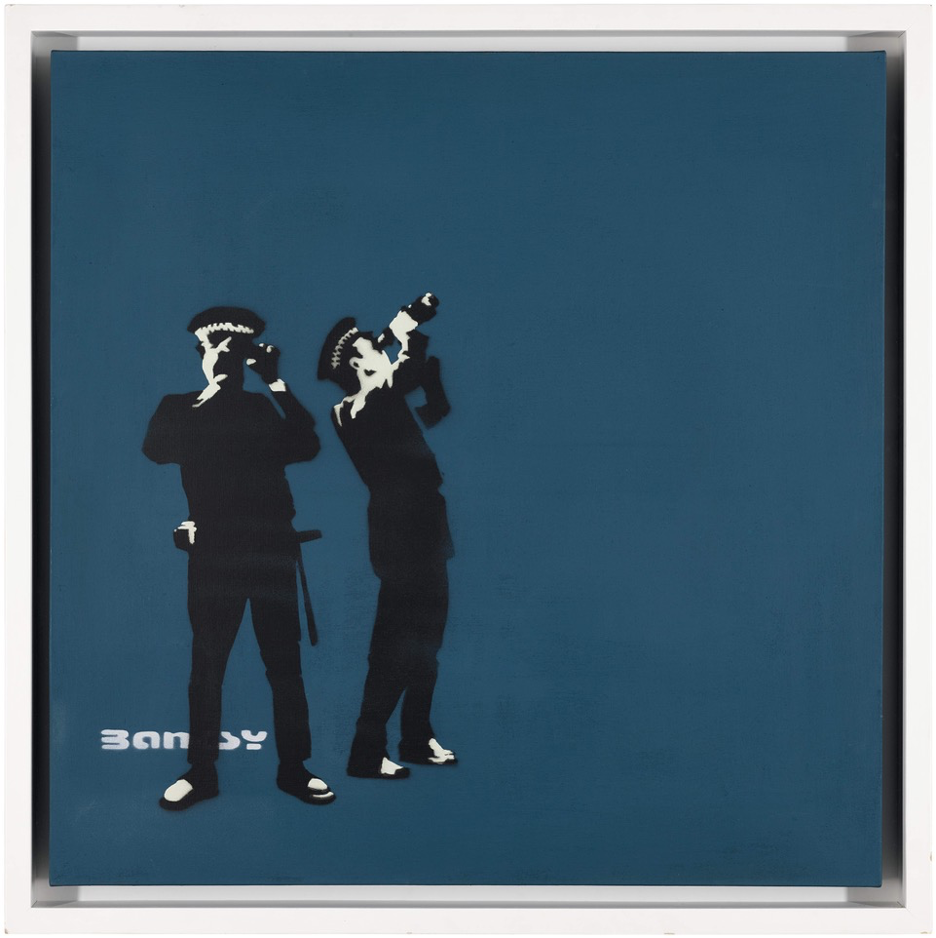Key takeaways
- A rare look at the Banksy work featured in Yieldstreet’s Art Equity Fund III.
- Sotheby’s Head of Private Sales (Americas) Courtney Kremers explains why Yieldstreet’s approach is calculated to achieve investment returns .
- A $1.4 million Banksy self destructed after the auction gavel came down.
In the final moments of a 2018 bidding war at Sotheby’s London, an auctioneer slammed his gavel down, announcing that for $1.4 million, someone had acquired one of street artist Banksy’s most iconic works: a silhouetted girl reaching for a heart-shaped balloon as it floated away. Courtney Kremers was there: the audience clapped, the auctioneer continued his closing remarks—but then a loud beeping was heard. The murmur in the room soon became something more frenetic, more restless. Before everyone’s eyes, the work of art was self-destructing in real-time as it passed through a shredder that had been strategically hidden inside its frame.
“I’ll never forget it,” recalls Courtney Kremers, the Head of Private Sales, Americas, and a Senior Specialist for Post-War and Contemporary Art at Sotheby’s. “It was pandemonium at the time,” she says of the in-person experience. “It really catapulted Banksy onto this international household-status level that probably only a handful of artists have [had].” When that same work returned to auction three years later, retitled “Love is in the Bin,” it sold for a record $25.4 million.
Ranked the fifth best-selling artist ever at auction, Banksy’s anti-war and anti-imperialist themes have established him as ‘enfant terrible’ of the art world. Between 2007 and 2021, 196 of the artist’s paintings commanded nearly $193 million. “A huge expansion in the market,” notes Kremers, who works closely with Yieldstreet’s Rebecca Fine, the Managing Director of Athena Art Finance, on sourcing artworks for the company’s Art Equity Funds. Athena’s proprietary data analytics also indicate that during this same period, the value of these artworks increased at a compound annual growth rate of 25.8 percent annually. “The average price of a single work went up a whopping 675%,” says Kremers.

And so it was with great excitement that she and Fine recently met to reveal the specific Banksy painting featured in Yieldstreet’s Art Equity Fund III. Titled “Avon and Somerset Constabulary,” the painting, created in 2001, features two police officers with binoculars, looking lost. Banksy and the police have a complicated relationship, because UK anti-graffiti laws were severely enforced when Banksy began making street art. The work has had only one previous owner who purchased the work shortly after its creation. “It’s ‘fresh to the market,’” says Kremer. In other words, it’s a work of art that has rarely been seen until this moment, and this provenance contributes to the work’s value. It also exemplifies Yieldstreet’s commitment to acquiring only exceptional examples of each artist’s most iconic subject matter, from the most important period of their artistic output as a means of maximizing the resale value, states Kremers:
“I’m really impressed with the quality of work that Yieldstreet is buying. You’re buying artists with rising markets, you’re buying under-appreciated artists who now finally have strong institutional and galleries’ support. And you also have great access to information that can tell you if a market is going to be rising or you can act in places where it’s really just an opportunistic moment for that object and that price.”
A reveal of this sort is rare for Yieldstreet, which sources artworks from a deep network of esteemed auction houses, art dealers, and private sellers without disclosing the names or images of the artwork, or the prices at which those works were acquired by the Fund. It’s an approach designed to optimize the resale value of the works. “A gallerist is protective of their artists’ market and it could push the prices down [if the purchase prices were made public],” says Kremer. Fine likes to use real estate as an analogy. “If a comparable apartment in your building sells at a discount, that hurts the market price for your apartment as well,” she says. Works are also often held for a period of four to five years, making it easier for Yieldstreet to continue sourcing the best artworks from the best sellers. “It’s important that you aren’t flipping the works,” says Kremers. “That’s a concern that a lot of our sellers have when they come to Sotheby’s.”
According to Kremers, [Yieldstreet is] curating the funds the way experienced art collectors who have an eye towards future value do. She explains:
“Diversification is one of the core principles of good investing and the same applies for art investing as well. The idea that you shouldn’t have all your eggs in one basket because artists or artworks can fall in and out of favor and when that happens, you really have 100% exposure to depreciation in value. So experienced art collectors buy artworks by a variety of different artists.”.
Moreover, this Banksy reveal offers a clear window into what investors can expect when they are shown comparable works of art on Yieldstreet’s platform. For Art Equity III, the comparable image was a nearly identical work with a background that was pink instead of blue. Adds Kremers: “It is as close a comp as exists.”
To watch the reveal and delve deeper into Yieldstreet’s process, click the video link above.
What's Yieldstreet?
Yieldstreet provides access to alternative investments previously reserved only for institutions and the ultra-wealthy. Our mission is to help millions of people generate $3 billion of income outside the traditional public markets by 2025. We are committed to making financial products more inclusive by creating a modern investment portfolio.






